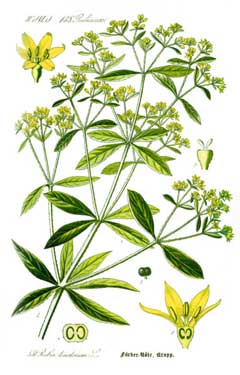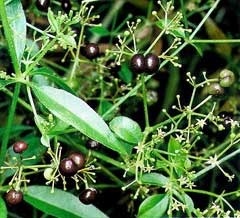 |
|
http://commons.wikimedia.org/wiki/File:Illustration_Rubia_tinctorum1.jpg |
 |
| http://ecoport.org |
Translate this page:
Summary
Physical Characteristics

 Rubia tinctorum is an evergreen Perennial growing to 1 m (3ft 3in) by 1 m (3ft 3in) at a medium rate.
Rubia tinctorum is an evergreen Perennial growing to 1 m (3ft 3in) by 1 m (3ft 3in) at a medium rate.
See above for USDA hardiness. It is hardy to UK zone 6. It is in leaf all year, in flower in June, and the seeds ripen in September. The species is hermaphrodite (has both male and female organs).
Suitable for: light (sandy) and medium (loamy) soils and prefers well-drained soil. Suitable pH: mildly acid, neutral and basic (mildly alkaline) soils. It can grow in semi-shade (light woodland) or no shade. It prefers dry or moist soil. The plant can tolerate maritime exposure.
UK Hardiness Map
US Hardiness Map
Synonyms
Galium rubia. Rubia acaliculata. Rubia iberica. Rubia sativa.
Plant Habitats
Hedgerow; Cultivated Beds;
Edible Uses
References More on Edible Uses
Medicinal Uses
Plants For A Future can not take any responsibility for any adverse effects from the use of plants. Always seek advice from a professional before using a plant medicinally.
Aperient Astringent Cholagogue Diuretic Emmenagogue
The root is aperient, astringent, cholagogue, diuretic and emmenagogue[4, 7, 21]. It is taken internally in the treatment of kidney and bladder stones[238]. The root is seldom used in herbal medicine but is said to be effective in the treatment of amenorrhoea, dropsy and jaundice[4]. The roots are harvested in the autumn from plants that are at least 3 years old. They are peeled and then dried[238]. When taken internally the root imparts a red colour to the milk, urine and bones, especially the bones of young animals, and it is used in osteopathic investigations[4, 200].
References More on Medicinal Uses
The Bookshop: Edible Plant Books
Our Latest books on Perennial Plants For Food Forests and Permaculture Gardens in paperback or digital formats.

Edible Tropical Plants
Food Forest Plants for Hotter Conditions: 250+ Plants For Tropical Food Forests & Permaculture Gardens.
More

Edible Temperate Plants
Plants for Your Food Forest: 500 Plants for Temperate Food Forests & Permaculture Gardens.
More

More Books
PFAF have eight books available in paperback and digital formats. Browse the shop for more information.
Shop Now
Other Uses
Dye Polish
A very good quality red dye is obtained from the roots. Some reports say that 2 year old roots are used in the spring and autumn[61, 200, 238] whilst others say that 3 year old roots are used[169, 171]. The roots can be dried for later use[169]. The dye can also be extracted from the leaves[169]. This dye is also used medicinally[200]. The leaves and stem are prickly, the whorls of leaves having spines along the midrib on the underside[4]. This feature enables them to be used for polishing metalwork[4, 148].
Special Uses
References More on Other Uses
Cultivation details
Prefers a light sandy soil in full sun[14]. Plants grown in fertile well-limed soils produce more pigment in the root[169]. This plant was at one time widely cultivated for the red dye obtained from its roots, this dye is now manufactured chemically[200]. However, it is still cultivated in Europe as a medicinal dye plant. The plant produces many side roots that can travel just under the surface of the soil for some distance before sending up new shoots[4]. This species is closely related to R. peregrina[4].
References Carbon Farming Information and Carbon Sequestration Information
Temperature Converter
Type a value in the Celsius field to convert the value to Fahrenheit:
Fahrenheit:
The PFAF Bookshop
Plants For A Future have a number of books available in paperback and digital form. Book titles include Edible Plants, Edible Perennials, Edible Trees,Edible Shrubs, Woodland Gardening, and Temperate Food Forest Plants. Our new book is Food Forest Plants For Hotter Conditions (Tropical and Sub-Tropical).
Shop Now
Plant Propagation
Seed - best sown as soon as it is ripe in a cold frame. Stored seed can be very slow to germinate[200]. Prick out the seedlings when they are large enough to handle and grow them on in light shade in the greenhouse for the first year. Plant them out into their permanent positions in early summer. Division in spring or at any time in the growing season if the divisions are kept well watered until established[200]. Larger divisions can be planted out direct into their permanent positions. We have found it best to pot up the smaller divisions and grow them on in a lightly shaded position in a cold frame, planting them out once they are well established in the summer.
Other Names
If available other names are mentioned here
Native Range
TEMPERATE ASIA: Cyprus, Iran, Iraq, Jordan, Lebanon, Syria, Turkey, Armenia, Georgia, Tajikistan, Turkmenistan, Uzbekistan EUROPE: Russian Federation (European part), Ukraine (incl. Krym), Croatia AFRICA: Algeria, Libya, Tunisia
Weed Potential
Right plant wrong place. We are currently updating this section.
Please note that a plant may be invasive in one area but may not in your area so it's worth checking.
Conservation Status
IUCN Red List of Threatened Plants Status :

| Related Plants
|
| Latin Name | Common Name | Habit | Height | Hardiness | Growth | Soil | Shade | Moisture | Edible | Medicinal | Other |
| Adina rubella | | Shrub | 1.8 |
-
| | LMH | SN | M | 0 | 1 | |
| Asperula cynanchica | Squinancy Wort | Perennial | 0.4 |
4-8
| | LMH | SN | DM | 0 | 1 | 1 |
| Asperula tinctoria | Dyer's Woodruff | Perennial | 0.3 |
4-8
| | LMH | SN | DM | 0 | 0 | 1 |
| Borojoa patinoi | Borojo | Tree | 8.0 |
10-12
| M | LMH | FS | M | 4 | 2 | 0 |
| Carapichea ipecacuanha | Ipecac | Shrub | 0.5 |
10-12
| M | LMH | FS | M | 0 | 4 | 0 |
| Cephalanthus occidentalis | Button Bush, Common buttonbush, Button Willow, Honey Bells, Buttonbush | Shrub | 7.0 |
4-10
| | LMH | SN | MWe | 0 | 2 | 1 |
| Chiococca alba | West Indian Snow Berry, David's rot, Skunk-root, Snowberry. | Shrub | 6.0 |
10-12
| M | LMH | N | M | 0 | 2 | 1 |
| Ciliosemina pedunculata | Ciliosemina | Shrub | 3.0 |
10-12
| | LMH | N | M | 0 | 4 | 0 |
| Cinchona calisaya | Peruvian Bark, Quinine | Tree | 6.0 |
10-12
| M | LM | SN | M | 2 | 5 | 2 |
| Cinchona officinalis | Lojabark | Tree | 8.0 |
10-12
| M | LM | SN | M | 2 | 5 | 2 |
| Cinchona pubescens | Quinine tree, Red Bark, Cinchona, Quina, Quinquina, Quinine Bark, Peruvian Bark, Jesuit's Bark | Tree | 15.0 |
10-12
| F | LM | SN | M | 2 | 5 | 2 |
| Coffea arabica | Coffee Arabica | Shrub | 6.0 |
9-11
| M | MH | SN | M | 3 | 3 | 3 |
| Coprosma acerosa | Sand Coprosma | Shrub | 0.5 |
7-10
| | LM | SN | M | 2 | 0 | 1 |
| Coprosma areolata | | Shrub | 5.0 |
8-11
| | LM | SN | M | 1 | 0 | 1 |
| Coprosma atropurpurea | | Shrub | 0.1 |
6-9
| | LM | SN | M | 1 | 0 | 1 |
| Coprosma billardieri | Native Currant | Shrub | 3.0 |
8-11
| | LM | SN | M | 1 | 0 | 1 |
| Coprosma brunnea | | Shrub | 0.1 |
7-10
| | LM | SN | M | 2 | 0 | 3 |
| Coprosma foetidissima | | Shrub | 5.0 |
8-11
| | LM | SN | M | 1 | 0 | 1 |
| Coprosma grandifolia | | Shrub | 5.0 |
8-11
| | LM | SN | M | 1 | 1 | 1 |
| Coprosma hirtella | Rough Coprosma | Shrub | 2.0 |
8-11
| | LM | SN | M | 1 | 0 | 1 |
| Coprosma lucida | | Shrub | 5.0 |
7-10
| | LM | SN | M | 2 | 0 | 1 |
| Coprosma moorei | | Shrub | 0.1 |
8-11
| | LM | SN | M | 1 | 0 | 1 |
| Coprosma nitida | | Shrub | 2.0 |
7-10
| | LM | SN | M | 2 | 0 | 1 |
| Coprosma petriei | | Shrub | 0.1 |
6-9
| | LM | SN | M | 1 | 0 | 3 |
| Coprosma propinqua | | Shrub | 6.0 |
6-9
| | LM | SN | M | 1 | 0 | 2 |
| Coprosma pumila | | Shrub | 0.1 |
6-9
| | LM | SN | M | 1 | 0 | 1 |
| Coprosma repens | Mirror Plant, Creeping mirrorplant | Shrub | 2.0 |
8-11
| | LM | SN | M | 1 | 0 | 1 |
| Coprosma rhamnoides | | Shrub | 2.0 |
7-10
| | LM | SN | M | 1 | 0 | 1 |
| Coprosma robusta | | Shrub | 5.0 |
8-11
| | LM | SN | M | 1 | 1 | 1 |
| Coprosma rotundifolia | | Shrub | 2.4 |
8-11
| | LM | SN | M | 1 | 0 | 1 |
|
|
Growth: S = slow M = medium F = fast. Soil: L = light (sandy) M = medium H = heavy (clay). pH: A = acid N = neutral B = basic (alkaline). Shade: F = full shade S = semi-shade N = no shade. Moisture: D = dry M = Moist We = wet Wa = water.
Now available:
Food Forest Plants for Mediterranean Conditions
350+ Perennial Plants For Mediterranean and Drier Food Forests and Permaculture Gardens.
[Paperback and eBook]
This is the third in Plants For A Future's series of plant guides for food forests tailored to
specific climate zones. Following volumes on temperate and tropical ecosystems, this book focuses
on species suited to Mediterranean conditions—regions with hot, dry summers and cool, wet winters,
often facing the added challenge of climate change.
Read More
Expert comment
Author
L.
Botanical References
200
Links / References
For a list of references used on this page please go here
Readers comment
© 2010, Plants For A Future. Plants For A Future is a charitable company limited by guarantee, registered in England and Wales. Charity No. 1057719, Company No. 3204567.